What Climate Zone Is Indiana? Understanding Its Regional Climate and Weather Patterns
Indiana is located in the Midwest region of the United States, bordered by Lake Michigan to the northwest, Ohio to the east, and Illinois to the west. This geographical positioning significantly influences its climate, making it essential for residents, gardeners, and those in agriculture to understand Indiana’s climate zone for effective planning and adaptation.
This overview will cover Indiana’s climate classification, USDA Hardiness Zones, and regional weather patterns.
Indiana’s General Climate Characteristics
Indiana predominantly experiences a humid continental climate, characterized by four distinct seasons:
– Hot, humid summers: Average temperatures in summer often reach the 80°F to 90°F range.
– Cold, snowy winters: Winter temperatures frequently drop below freezing, particularly in January and February.
– Mild transitional seasons: Both spring and fall offer moderate temperatures but can bring severe weather events.
Climate Zone Classification of Indiana
Koppen Climate Classification
According to the Koppen Climate Classification system, most of Indiana is classified as a humid continental climate (Dfa). This classification is marked by:
– Warm to hot summers
– Cold winters
However, parts of southern Indiana experience a humid subtropical climate (Cfa), which features milder winters and hot, humid summers[1][4].
USDA Hardiness Zone
Indiana primarily falls within USDA Hardiness Zones 5b to 6b, which is crucial for determining suitable plants for cultivation. The zones are as follows:
– Northern Indiana: Zone 5b (winter lows between -15°F and -10°F).
– Central Indiana: Zone 6a (winter lows between -10°F and 0°F).
– Southern Indiana: Zone 6b (winter lows between 0°F and -5°F), with some areas near the Ohio River classified as Zone 7a[2][6].
Regional Variations in Indiana’s Climate
Northern Indiana
– Experiences colder winters due to proximity to Lake Michigan.
– Commonly affected by lake-effect snow during winter months.
– Has a shorter growing season compared to the southern regions.
Central Indiana
– Features a more moderate climate than the north but still faces cold winters and warm summers.
– The Indianapolis area exemplifies typical humid continental weather patterns.
Southern Indiana
– Warmer and more humid with a longer growing season.
– Experiences less snowfall and milder winters compared to northern and central regions.
– Influenced by subtropical weather patterns due to its location near the Ohio River.
Seasonal Weather Patterns in Indiana
Summer
– Characterized by hot and humid conditions with temperatures often ranging from the 80s to 90s.
– Thunderstorms are frequent, with occasional severe weather including tornadoes.
Winter
– Cold temperatures prevail, with significant snowfall in northern regions.
– Central and southern parts may experience snow or ice storms.
Spring and Fall
– Spring features mild temperatures but can bring severe weather such as thunderstorms.
– Fall offers cooler, pleasant weather with reduced humidity and less severe weather activity.
Climate Change and Its Impact on Indiana
Climate change is increasingly affecting Indiana’s weather patterns:
– Warmer winters: With less snowfall and more ice storms expected.
– Extreme weather events: Increased frequency of heavy rainfall leading to flooding risks.
– Shifts in growing seasons: These changes particularly impact agriculture, notably in southern Indiana[1][3][4].
FAQs
What climate zone is most of Indiana in?
Most of Indiana falls within a humid continental climate zone (Dfa), characterized by warm summers and cold winters.
What are Indiana’s USDA Hardiness Zones?
Indiana is primarily classified into USDA Zones 5b to 6b, with variations across the state.
How does Indiana’s climate differ from north to south?
Northern Indiana experiences colder winters with more snow, while southern Indiana enjoys milder winters and more humid summers.
Does Indiana experience severe weather?
Yes, severe thunderstorms, tornadoes, and winter storms are common, especially during transitional seasons.
Is Indiana’s climate changing?
Yes, warmer winters, increased rainfall intensity, and shifts in growing seasons are all notable impacts of climate change on Indiana’s climate[3][4].
Conclusion
In summary, understanding that most of Indiana is classified as a humid continental climate helps residents plan effectively for gardening, agriculture, and daily living conditions. Awareness of these climatic variations is crucial as they influence local ecosystems and agricultural practices. As climate change continues to reshape these patterns, staying informed will be essential for adapting to future conditions.

Kyle Whyte is a notable scholar and professor at the University of Michigan, holding positions such as the George Willis Pack Professor in the School for Environment and Sustainability and Professor of Philosophy. Specializing in environmental justice, his work critically examines climate policy and Indigenous peoples’ ethics, emphasizing the nexus between cooperative scientific endeavors and Indigenous justice. As an enrolled Citizen Potawatomi Nation member, he brings a vital perspective to his roles as a U.S. Science Envoy and member of the White House Environmental Justice Advisory Council. His influential research is supported by various prestigious organizations including the National Science Foundation, and disseminated through publications in high-impact journals. Kyle actively contributes to global Indigenous research methodologies and education, with affiliations to numerous institutes and societies dedicated to traditional knowledge and sustainability. Recognized for his academic and community engagement, Kyle has earned multiple awards and served in various visiting professorships. His efforts extend to leadership positions on boards and committees focused on environmental justice nationwide.
